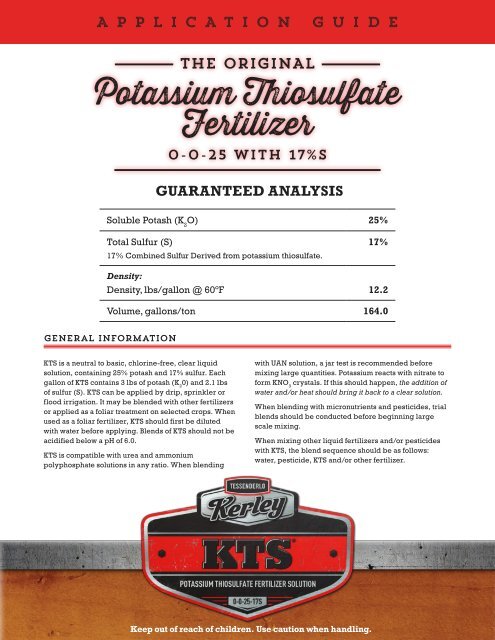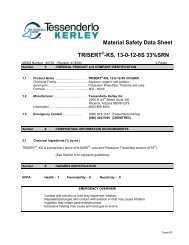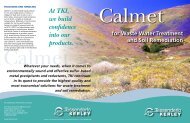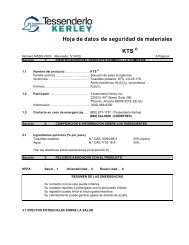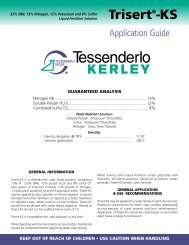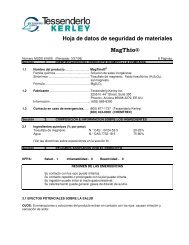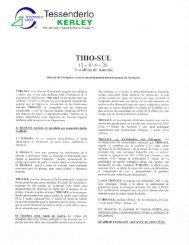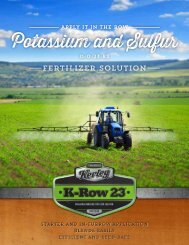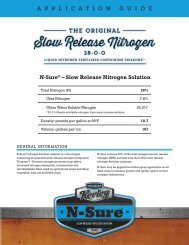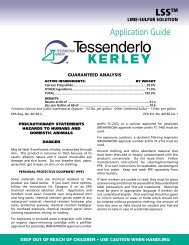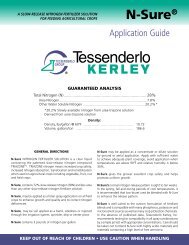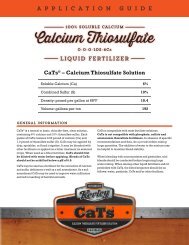KTS® Application Guide - Tessenderlo Kerley
KTS® Application Guide - Tessenderlo Kerley
KTS® Application Guide - Tessenderlo Kerley
Create successful ePaper yourself
Turn your PDF publications into a flip-book with our unique Google optimized e-Paper software.
APPLICATION GUIDE<br />
THE ORIGINAL<br />
Potassium Thiosulfate<br />
Fertilizer<br />
0-0-25 with 17%S<br />
GUARANTEED ANALYSIS<br />
Soluble Potash (K 2<br />
O) 25%<br />
Total Sulfur (S) 17%<br />
17% Combined Sulfur Derived from potassium thiosulfate.<br />
Density:<br />
Density, lbs/gallon @ 60ºF 12.2<br />
Volume, gallons/ton 164.0<br />
General Information<br />
KTS is a neutral to basic, chlorine-free, clear liquid<br />
solution, containing 25% potash and 17% sulfur. Each<br />
gallon of KTS contains 3 lbs of potash (K 2<br />
0) and 2.1 lbs<br />
of sulfur (S). KTS can be applied by drip, sprinkler or<br />
flood irrigation. It may be blended with other fertilizers<br />
or applied as a foliar treatment on selected crops. When<br />
used as a foliar fertilizer, KTS should first be diluted<br />
with water before applying. Blends of KTS should not be<br />
acidified below a pH of 6.0.<br />
KTS is compatible with urea and ammonium<br />
polyphosphate solutions in any ratio. When blending<br />
with UAN solution, a jar test is recommended before<br />
mixing large quantities. Potassium reacts with nitrate to<br />
form KNO 3<br />
crystals. If this should happen, the addition of<br />
water and/or heat should bring it back to a clear solution.<br />
When blending with micronutrients and pesticides, trial<br />
blends should be conducted before beginning large<br />
scale mixing.<br />
When mixing other liquid fertilizers and/or pesticides<br />
with KTS, the blend sequence should be as follows:<br />
water, pesticide, KTS and/or other fertilizer.<br />
Keep out of reach of children. Use caution when handling.
PRECAUTIONARY<br />
STATEMENTS<br />
For further information consult a Material<br />
Safety Data Sheet (MSDS) or visit our<br />
website at: www.tkinet.com.<br />
WARNING: Plant and leaf injury may<br />
occur on some crops when certain<br />
weather and growing conditions are<br />
present. The user assumes all risks of<br />
use and handling.<br />
GENERAL APPLICATION<br />
KTS may be applied to a wide variety<br />
of ornamental, turf, green-house and<br />
other agricultural crops. Potassium<br />
requirements for most crops increase<br />
dramatically during periods of<br />
rapid growth and fruit development.<br />
<strong>Application</strong> of KTS should be made<br />
based on soil, soil release rate test and/<br />
or plant tissue analysis for potassium.<br />
SOIL APPLIED<br />
STARTER FERTILIZER: Apply 1 to 4<br />
gallons of KTS per acre by itself or with<br />
other starter fertilizers in a 2"x 2" or a 2"x<br />
0" placement (2 inches to the side of the<br />
seed). See blend chart on next page.<br />
POP-UP FERTILIZER: Wheat and<br />
Other Small Grains: Apply 2 to 4 quarts<br />
per acre by itself or with other liquid<br />
pop-up fertilizers.<br />
Corn: Apply 2 to 4 quarts of KTS per<br />
acre by itself or with other liquid pop-up<br />
fertilizers.<br />
Tomatoes and Other Small Seeded<br />
Crops: Apply 2 to 3 quarts of KTS per<br />
acre by itself or with other liquid pop-up<br />
fertilizers.<br />
SIDEDRESS: KTS may be surface<br />
banded or knife injected as a source of<br />
potassium and sulfur. Rates may vary<br />
depending on crop requirement and<br />
soil analysis.<br />
SOME EXAMPLES<br />
OF STARTER<br />
FERTILIZER BLENDS<br />
Blend<br />
6-21-6-4S<br />
7-25-6-4S<br />
10-13-5-3S<br />
Products<br />
Pounds<br />
per Ton<br />
10-34-0 1235<br />
KTS 480<br />
Water 285<br />
10-34-0 1470<br />
KTS 480<br />
Water 50<br />
UAN 32 388<br />
10-34-0 765<br />
KTS 400<br />
Water 447<br />
Always do a jar test before making<br />
large quantities. When blending KTS<br />
and UAN 32 always have as much water<br />
in the blend as either one of these<br />
products.<br />
FOLIAR FERTILIZER<br />
APPLICATION<br />
<strong>Application</strong> rates are only for the crops<br />
listed below. For recommendations<br />
regarding crops not listed, contact<br />
your local fluid fertilizer dealer or your<br />
<strong>Tessenderlo</strong> <strong>Kerley</strong> representative. KTS<br />
may be applied by ground or air. It is<br />
recommended that the addition of 2 to 4<br />
quarts of either TRISERT-NB ® (26-0-0),<br />
TRISERT-CB ® (26-0-0-0.5B) or N-SURE ®<br />
(28-0-0) be applied with the KTS.<br />
TRISERT-CB, TRISERT-NB and N-SURE<br />
are <strong>Tessenderlo</strong> <strong>Kerley</strong>’s triazone based<br />
slow-release liquid nitrogen fertilizers<br />
that improve the foliar absorption of KTS.<br />
Cotton: Apply 4 to 6 quarts/acre<br />
beginning from the 1st through to the 4th<br />
week of bloom along with 2 qts/acre of<br />
N-Sure.<br />
Potatoes: Apply 4 to 6 quarts/acre<br />
beginning at tuber initiation, apply<br />
second treatment at golf ball size and<br />
third treatment at tuber bulking.<br />
Small Grains: Apply 2 to 4 quarts/acre<br />
at tillering to early boot stage.<br />
Canola: Apply 8 to 10 quarts/acre at<br />
bolting.<br />
Alfalfa: Apply 4 to 6 quarts/acre at<br />
crown green up or on regrowth after<br />
cutting.<br />
Rice: Apply 4 to 6 quarts/acre at panicle<br />
initiation.<br />
Peas and Lentils: Apply 2 to 4 quarts/<br />
acre during late bud to 10% bloom.<br />
Tomatoes: Begin at fruit set, apply 2 to 4<br />
quarts/acre every 7 to 14 days.<br />
Soybeans: 4 to 6 quarts/acre at R1 to R2<br />
stage.<br />
Sugar Beets: 1 to 2 gallons/acre at<br />
bloom.<br />
Apples, Apricots, Almonds, Citrus,<br />
Pecans: Apply KTS at 2 to 6 quarts per<br />
acre in a minimum of 100 gallons of<br />
water spray solution. Begin application at<br />
first full leaf and apply as needed during<br />
the growing season. For concentrated<br />
sprays of less than 100 gallons per acre,<br />
reduce the rate of KTS to stay within the<br />
recommended solution ratio (i.e., 50<br />
gallons of water per acre equals 1 to 3<br />
quarts of KTS per acre).<br />
Vinifera Vines: Begin 2 weeks after<br />
bloom. Apply 2 to 4 quarts of KTS per<br />
acre in a minimum of 50 gallons of water.<br />
Repeat treatment in 7 to 10 days. Do not<br />
apply foliar to Concord grapes.<br />
Recommendations listed are for KTS<br />
and TRISERT application only. The<br />
addition of other products to the<br />
spray mix is the responsibility of the<br />
applicator and not TKI.
FERTIGATION<br />
FLOOD AND FURROW IRRIGATION:<br />
Trees and Vines: Apply 10 to 15<br />
gallons of KTS per acre per application<br />
beginning at full leaf, schedule as<br />
needed.<br />
Vegetable and Row Crops: Apply<br />
10 to 15 gallons of KTS per acre per<br />
application; make second application<br />
based on crop requirements.<br />
SPRINKLER/CENTER PIVOT<br />
IRRIGATION:<br />
Trees (Under): Apply 5 to 8 gallons per<br />
acre per application every 10 to 14 days<br />
based on crop requirements.<br />
Trees (Overhead): Apply 3 to 5 gallons<br />
per acre per application every 10 to 14<br />
days based on crop requirements.<br />
Vines: Apply 3 to 5 gallons per acre per<br />
application every 10 to 14 days based on<br />
crop requirements.<br />
Vegetable and Row Crops: Beginning<br />
at the 3rd to 4th leaf stage, apply 3 to 5<br />
gallons per acre per application every 7<br />
to 10 days based on crop requirements.<br />
After injection, allow enough irrigation<br />
time to rinse the plants of any residual<br />
fertilizer.<br />
DRIP IRRIGATION:<br />
Young Trees: 3 to 5 gallons per acre<br />
during the season when roots are<br />
actively growing.<br />
Mature Trees: 5 to 10 gallons per acre<br />
per application.<br />
Vines: <strong>Application</strong> of KTS can be made<br />
about any time through the growing<br />
period. Potassium requirement is<br />
highest at the beginning and through<br />
fruit development. Mature vines, apply<br />
from 5 to 10 gallons per acre as required<br />
according to tissue analysis. Young<br />
vines, apply 3 to 5 gallons per acre.<br />
Vegetable and Row Crops: 3 to 5<br />
gallons per acre per application two to<br />
four times during the growing season.<br />
CAUTION<br />
Do not apply KTS to foliage of crops<br />
sensitive (foliar burn) to sulfur.<br />
When blending with TRISERT-CB<br />
fertilizer solution, containing boron,<br />
boron (B) may cause injury to crops<br />
other than those listed on the TRISERT-<br />
CB application guide. Consult the<br />
TRISERT-CB application guide for<br />
further information.<br />
Do not apply to foliage of any crop when<br />
temperatures are above 90°F. Apply KTS<br />
early morning or late evening.<br />
When mixing KTS or any liquid fertilizer<br />
with pesticides always keep agitators<br />
running during filling and spraying<br />
operations. Failure to maintain agitation<br />
may cause separation of products<br />
resulting in uneven spray application.<br />
Many crops are sensitive to salts during<br />
germination. When soil moisture is<br />
low, delayed crop emergence and/or<br />
phytotoxicity may occur when fertilizer<br />
is placed too close to the seed.<br />
Do not use KTS in pop-up fertilizer when<br />
soil moisture is limited, soil salinity is<br />
above an electrical conductivity of 1.0<br />
or when irrigation is delayed such that<br />
germination may be affected.<br />
Do not apply KTS with knife injectors<br />
or other types of fertilizer injecting<br />
equipment that may cause root pruning.<br />
Sprinkler application of KTS and other<br />
liquid fertilizers over an established<br />
crop may cause foliar injury to a crop if:<br />
injection period is short enough to cause<br />
an excessive amount of fertilizer to<br />
accumulate on the leaves, temperatures<br />
are above 90°F and humidity less<br />
than 30%, fertilizer rates are higher<br />
than recommended, irrigation pump<br />
breaks down during or immediately<br />
after injecting fertilizer, and /or any<br />
combination of these conditions.<br />
Crop injury may result from unusual<br />
weather conditions, failure to<br />
follow label directions, or improper<br />
application practices all of which are<br />
out of control of the manufacturer or<br />
seller. The directions on this label are<br />
believed to be reliable and should be<br />
followed carefully.<br />
Do not apply KTS foliar with crop oil<br />
sprays. Allow at least 10 days before or<br />
after an application of crop oil before<br />
applying KTS as a foliar.<br />
Do not apply KTS or other thiosulfate<br />
fertilizers while chlorinating irrigation<br />
system. Thiosulfates will neutralize the<br />
chlorine.<br />
Do not mix KTS with acid or acidic<br />
fertilizers below a pH of 6.0. KTS will<br />
decompose.<br />
Do not use high pressure sprays (greater<br />
than 60 psi) when applying KTS over the<br />
top of a crop.<br />
DIRECTIONS FOR USE<br />
ON TURF GRASSES<br />
LAWN CARE PROGRAM<br />
KTS may be applied as a spray<br />
application on all turf grasses – cool,<br />
transitional and warm season. KTS<br />
should be applied as a dilute solution<br />
via handgun or spray boom application<br />
and may be injected through the<br />
irrigation system. It is recommended<br />
that KTS be tank mixed with N-SURE<br />
based, slow-release nitrogen solutions<br />
containing triazone when making<br />
handgun and spray boom applications<br />
for increased efficiencies and safety.<br />
Apply with sufficient water to achieve<br />
adequate plant coverage especially<br />
during periods of low humidity and high<br />
temperature, to achieve the maximum<br />
benefit of foliar fertilization.<br />
APPLICATION: Initiate application<br />
in spring when first green up appears<br />
and repeat as needed during the active<br />
growing season. Apply in 1½ to 4<br />
gallons of spray solution per 1000 square<br />
feet.<br />
COOL, TRANSITIONAL AND WARM<br />
SEASON GRASSES: Rates may vary<br />
from ¼ to 1 lb of potash (11 to 43 fluid<br />
ounces) per 1000 square feet in 4 to 6<br />
applications at 8 to 12 week intervals for<br />
a total application rate of 1¼ to 6 lbs of<br />
potassium per 1000 square feet per year.<br />
It is recommended that KTS be applied<br />
in conjunction with ¼ to 1 lb (10 to 40<br />
fluid ounces) of nitrogen supplied from
N-SURE based slow-release nitrogen<br />
fertilizer solutions to aid in the absorption<br />
of the potassium and sulfur by the plant.<br />
FERTIGATION: KTS may be injected<br />
during each irrigation at rates of 11 to 22<br />
fluid ounces (¼ to ½ lb of K 2<br />
0) per 1000<br />
square feet. Rates will vary in accordance<br />
with the irrigation schedule. Use the<br />
lower rate in more frequent waterings.<br />
GOLF Course PROGRAM<br />
FAIRWAYS: KTS may be used as the sole<br />
potassium source in fairway fertilization<br />
with the additional benefit of sulfur to aid<br />
in more efficient nitrogen utilization. KTS<br />
may also he combined with N and P 2<br />
0 5<br />
sources to supply the desired fertilizer<br />
blend for proper fairway nutrition. It<br />
is recommended that the applications<br />
be split to coincide with the nutritional<br />
demands of the cultivars present and the<br />
cultural program of the superintendent.<br />
Suggested rates will vary from 3 to 6 lbs<br />
of potash (1 to 2 gallons of KTS) per 1000<br />
square feet per growing season.<br />
TEE AND GREEN: For the spoon<br />
feeding of tees and greens apply 1/4 lb<br />
of K 2<br />
0 (11 fluid ounces of KTS) in 2 to 4<br />
gallons of total spray solution per 1000<br />
square feet every 14 days. <strong>Application</strong><br />
may be made in conjunction with the<br />
turf protection chemical program. In the<br />
absence of published data, a jar test is<br />
recommended to ensure compatibility.<br />
Irrigation is recommended following<br />
application.<br />
FERTIGATION: KTS and blends may<br />
be injected during each irrigation<br />
utilizing the current technology and<br />
equipment available to the golf course<br />
superintendent. It is recommended<br />
that rates be in accordance with soil<br />
testing data and with the equipment<br />
manufacturers’ recommendations.<br />
KTS is compatible with N-SURE based<br />
slow-release nitrogen solutions, urea<br />
and ammonium polyphosphate solution<br />
in any ratio. When blending with UAN<br />
solution, a jar test is recommended to<br />
ensure compatibilities. Potassium reacts<br />
with nitrate to form KNO 3<br />
crystals. If this<br />
should occur, the addition of water and/<br />
or heat should bring the blend back to a<br />
clear solution.<br />
In the absence of specific information<br />
concerning the mixing with micro<br />
nutrients and/or crop protection<br />
chemicals, it is recommended that a jar<br />
test be conducted to ensure compatibility.<br />
KTS gives the turf professional a<br />
completely soluble potassium and<br />
sulfur product that allows immediate<br />
plant utilization through both root<br />
uptake and foliar feeding. KTS may be<br />
applied throughout the growing season<br />
to correct potassium deficiencies and<br />
aid in increasing drought resistance,<br />
winter hardiness and overcoming the<br />
stress associated with insect and disease<br />
pressures.<br />
ORNAMENTAL TREES<br />
AND SHRUBS<br />
DEEP ROOT FEEDING: Deep root<br />
feeding applications may be made in<br />
either the spring or fall. In the spring,<br />
apply KTS after the frost is out of the<br />
ground, but before the tree has opened all<br />
its leaves. In the fall, wait until the tree has<br />
dropped most of its leaves or until the soil<br />
temperature has reached 50°F or less.<br />
Suggested rates of application are 1 to 3<br />
lbs of K 2<br />
0 per 1000 square feet (43 to<br />
128 ounces of KTS). Inject the KTS based<br />
fertilizer solution 8 to 12 inches deep<br />
on a grid pattern 2 to 3 feet apart so the<br />
area below the tree canopy plus one<br />
third of the area outside the canopy<br />
will be treated. When mixing KTS with<br />
phosphorous and nitrogen sources, a<br />
desirable N:P 2<br />
O 5<br />
:K 2<br />
0 analysis might<br />
range from a 1:2:3 to a 3:1:1 blend.<br />
FERTIGATION: KTS and blends with<br />
this fertilizer solution may be injected<br />
during each irrigation utilizing the<br />
current technology and equipment<br />
available to the professional applicator.<br />
It is recommended that rates be in<br />
accordance with soil testing data and<br />
with the equipment manufacturers’<br />
recommendations.<br />
FOLIAR SPRAYS: KTS may be used in<br />
a foliar tree and shrub feeding program<br />
and applied in conjunction with a turf<br />
protection chemical program. It is<br />
recommended that N-SURE based<br />
slow-release nitrogen be included in<br />
this foliar application to enhance the<br />
absorption of potassium by the plant.<br />
In the absence of specific data when<br />
used in conjunction with turf protection<br />
chemicals, it is recommended that a<br />
simple jar test be made to determine<br />
compatibility of all ingredients prior<br />
to mixing. KTS will help stimulate new<br />
growth, aid recovery from insect and<br />
disease damage, and enhance color.<br />
A suggested rate of application of KTS is<br />
1 gallon per 100 gallons of spray solution.<br />
For concentrated sprays of less than<br />
100 gallons, reduce the rate of KTS to<br />
stay within the recommended solution<br />
ratio. For example, use 2 quarts when<br />
using a mixture of 50 gallons of spray<br />
solution. CAUTION should be exercised<br />
by the professional applicator before<br />
applying KTS and blends including this<br />
product to sensitive trees and shrubs.<br />
It is recommended that applicators<br />
complete their own trials in absence of<br />
specific data.<br />
FERTIGATION: KTS and N:P:K blends<br />
containing KTS may be injected through<br />
the irrigation system utilizing the current<br />
technology and equipment available to<br />
the arborist. Rates may vary due to needs<br />
of specific varieties.<br />
Refer to the following table when varying<br />
the rates of potash and sulfur when using<br />
KTS.<br />
KTS K 2<br />
O S<br />
fl. oz. per<br />
1000 ft 2 pounds per 1000 ft 2<br />
11 0.26 0.18<br />
22 0.52 0.36<br />
32 0.75 0.53<br />
43 1.00 0.71<br />
When mixing KTS and N-SURE Pro<br />
30-0-0 slow-release nitrogen solution,<br />
the following approximate analysis will<br />
result. When applying any of the below<br />
combinations, use a minimum of 1½<br />
gallons of spray solution per 1000 square<br />
feet and/or sufficient carrier to achieve<br />
adequate coverage for effective plant<br />
utilization.
KTS MIXING PROCEDURES:<br />
• Add ½ of water to spray tank, begin circulating.<br />
• Add recommended amount of KTS or other N and P sources.<br />
• Add compatible micronutrients.<br />
Ratio (V/V)<br />
KTS :<br />
N-sure ® Pro 30-0-0 =<br />
(50% SRN)<br />
= Approximate Analysis<br />
1 : 1 = 14-0-13<br />
2 : 1 = 9-0-17<br />
3 : 1 = 7-0-19<br />
4 : 1 = 5-0-10<br />
5 : 1 = 4-0-21<br />
• Add flowable materials.<br />
• Add emulsifiables.<br />
• Add any soluble powders and/or water soluble fertilizers. All should be predispersed<br />
in water before adding to the spray tank solution.<br />
• Complete filling of spray tank to desired volume and continue circulating prior to and<br />
during spray application.<br />
• Flush all spray and nurse equipment after usage.<br />
For additional information on N-SURE based slow-release nitrogen solutions, ask your<br />
vendor for a current application guide on these products.<br />
CAUTION (APPLICATION):<br />
• Do not apply KTS to the foliage of plants sensitive (foliar burn) to sulfur.<br />
• Do not apply to foliage of any plant when temperatures are above 90°F.<br />
• When mixing KTS or any liquid fertilizer with pesticides, always maintain vigorous<br />
agitation during filling and spraying operations.
Technical Data<br />
KTS<br />
0-0-25+17S<br />
<strong>Tessenderlo</strong> <strong>Kerley</strong>, Inc. warrants only that this product<br />
conforms to the product description on the label.<br />
Plant Nutrient Content Wt. %<br />
<strong>Tessenderlo</strong> <strong>Kerley</strong>, Inc. makes no representation or<br />
Soluble Potash (K 2<br />
O) 25.00<br />
Total Sulfur (S) 17.00<br />
17% Combined Sulfur<br />
Typical Properties<br />
Specific Gravity 1.46<br />
pH 7.00 to 8.20<br />
Appearance<br />
Clear, Colorless<br />
Salting-Out Temperature, ºF<br />


